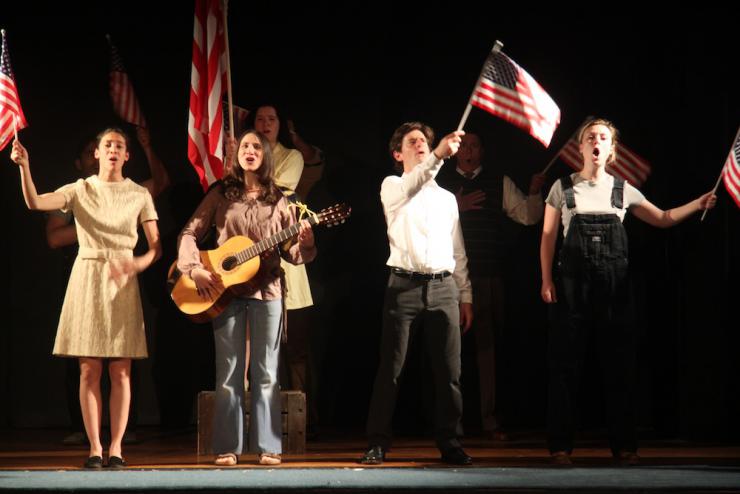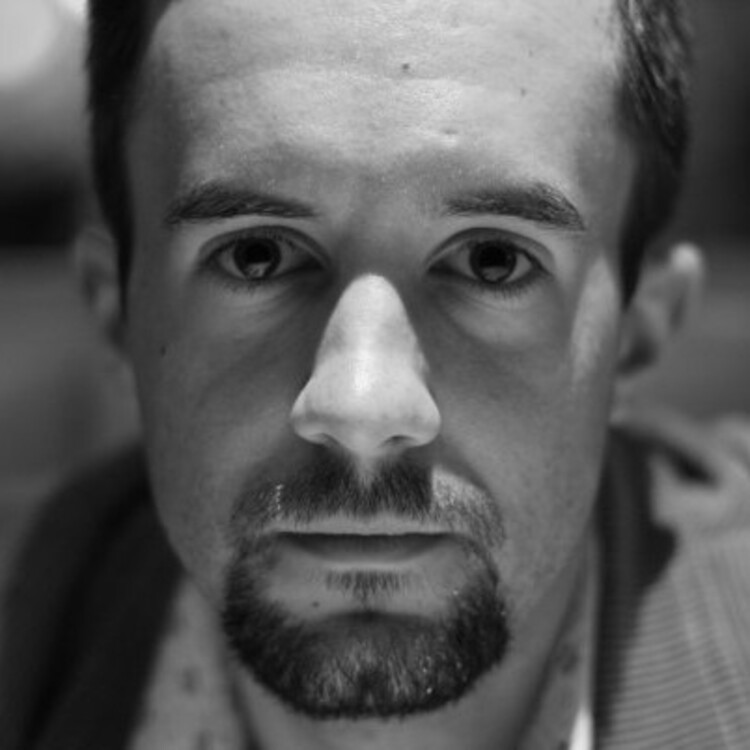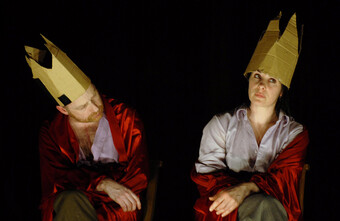Encounters with Grace
Sarah Ruhl's Passion Play in Toronto's East End
The Rule of St. Benedict, which has guided those in religious life for approximately 1500 years, says: “Let all guests who arrive be received like Christ, for He is going to say, ‘I came as a guest, and you received me.’”
On the walls of Shakespeare & Company in the Rue de la Bûcherie in Paris, the words of Yeats are prominently displayed: “Be Not Inhospitable To Strangers Lest They Be Angels In Disguise.”
The Polish director and theoretician Juliusz Osterwa said that, “God created theatre for those for whom church does not suffice.”
These three quotations were floating around my head after witnessing the extraordinary four-hour-plus theatrical event that constituted the Canadian premiere of Sarah Ruhl’s Passion Play (June 6 – 30), presented by Crow’s Theatre and produced by Outside the March, Convergence Theatre, and Sheep No Wool. And there really is no other word for it; the entirety of the evening, which began at 7pm and didn’t end until well after 11pm, was an experience so immersive that we in the audience began to feel less like we were watching a play than we were participating in a communal Passion, with dozens of participants ranging from eleven primary actors, eight “Passion Players” who doubled as chorus and crew, three directors, and us.
Ruhl’s play divides neatly into three parts—really three dramaturgically complete playlets—set in the North of England during the reign of Elizabeth I, who successfully suppressed many of the hugely popular Passion cycles in the North; Oberammergau in Bavaria in 1934, after Hitler’s rise to power; and the Black Hills of South Dakota, ranging from the height of the Vietnam War through to Reagan’s America. The primary actors retain their analogous parts throughout each of the three parts, and each playlet is directed by a different director from one of the three producing companies (Mitchell Cushman, Alan Dilworth, and Aaron Willis). In each part we witness a group of actors preparing and presenting a version of the Passion, while simultaneously enacting moments of the Passion itself. This level of dramaturgical sophistication, combined with a heightened language and poetic sensibility, might be said to be hallmarks of Ruhl’s work, and the actors and directors involved in this ambitious event have more than lived up to the task of honoring that sophistication.
The suppression of Catholicism in England was at its height in the 1570s, priests were hidden in priest holes and smuggled out of the country, and Elizabeth’s spies promoted anti-Catholic foment.
The first part took place in Withrow Park in Toronto’s East End. The suppression of Catholicism in England was at its height in the 1570s, priests were hidden in priest holes and smuggled out of the country, and Elizabeth’s spies promoted anti-Catholic foment. Then, as now, the North might well be described as a “marginal constituency” where the authority from the Royal capital might not be felt as immediately as it was in London. Thus, although anti-Catholic policies had been in place since Tudor times, Catholicism and Passion cycles still flourished in the North, particularly at York, until the outright suppression of the Passion cycles in 1575.

Very early in this playlet, after establishing our locale and that we are witnessing a Passion play, a cloaked stranger emerges from the park and queries John (played by Andrew Kushnir), whether this is the site of the famous Passion, and whether he, John, was the famed actor who plays Jesus in the play. When it is established that it is and he is, the stranger removes his cloak to show that he is a visiting friar (played by Richard Binsely). The friar is welcomed to the community, housed and fed, and observes the town’s process of building the Passion.
The first playlet offers the template for the others, and the audience tracks the particulars: the character of Mary 1—the Virgin—is decidedly not (played to great effect by Mayko Nguyen); Mary 2—Magdalene—is loyal (played by Julie Tepperman); Jordan Pettle plays the director in all three; and the tension between Kushnir’s character and Cyrus Lane’s forms the emotional backbone of the show. In the first two playlets, Amy Keating’s characters, the Village Idiot in Elizabethan England and Violet, a young Jewish girl in Oberammergau, both prophesize of red skies and danger to come. And Maev Beaty’s masterful performances as Elizabeth I, Adolf Hitler, and Ronald Reagan stole and solidified the show—from monarch to dictator to actor/president in a world that seems increasingly indifferent to the lives of other human beings.
And Maev Beaty’s masterful performances as Elizabeth I, Adolf Hitler, and Ronald Reagan stole and solidified the show—from monarch to dictator to actor/president in a world that seems increasingly indifferent to the lives of other human beings.
In each playlet a different aspect is heightened reflecting the tenor and preoccupation of the times. In England, the importance of the two Marys becomes paramount and the suffering of Christ as a redemptive act dominates the atmosphere of the Passion. In Germany, during Hitler’s dictatorship the focus is on highlighting those passages in the Gospel According to John that place the blame for Jesus’s death firmly with the Jews. In South Dakota during Vietnam it becomes about Pilate’s culpability, acting as he did as a mere tool of the Roman Empire. An apt focus in an era when soldiers were being spit upon after returning from Vietnam—when questions about service, culpability, and responsibility haunted soldiers and civilians alike.
Entire theses can and will be written on Ruhl’s work, but here I want to talk specifically about strangers.
Could Ruhl be suggesting that we, citizens of the twenty-first century, no longer have the capacity to welcome strangers?
Richard Binsley plays two strangers in this production, first as the visiting friar, then as a visiting English theater scholar writing about the Passion at Oberammergau. The third playlet does not really have an analogous character. Knowing Ruhl’s work (and knowing something about the dramaturg she worked with), this does not seem to me to be accidental. Could Ruhl be suggesting that we, citizens of the twenty-first century, no longer have the capacity to welcome strangers? Could she be suggesting that our inability to receive strangers “like Christ” may keep us from experiencing the divine in our lives?
The progression seems clear in the playlets. The friar is welcomed with open arms to a community used to accepting strangers. That he was a religious stranger upped the stakes, and when he finally had to flee after Beaty’s imperious Elizabeth closed down the Passion, we felt a palpable sadness. In Oberammergau, the visiting English scholar was viewed not with acceptance but with suspicion. The room filled with tension when Hitler popped in and everyone immediately offered the Nazi salute except for the Englishman, who only stood after being stared at by the Nazis surrounding him. By the time we’re in South Dakota, we are the strangers, effectively ignored, looking on to a scene but not really being looked upon back.
We formed, if only for four hours, a small community of strangers, gathered together for this live human event.
Here is where the genius of this production really shines. By the time we looked on with familiar dis-ease at the Vietnam scene unfolding before us, we had all been together for nearly three hours. We began at the park and when that playlet ended we walked over to Eastminster United Church in a scene that was not totally unlike walking the Stations of the Cross (but with more people smoking). In between playlets two and three we had coffee and bagels together in the church basement. (And isn’t there just a certain smell that can only be found in church basements? Something like a mix of stale coffee and dish soap.) People who knew each other wandered over to say hello and catch up. We introduced ourselves to strangers. We formed, if only for four hours, a small community of strangers, gathered together for this live human event. As the producers say in their programme note, “We have been saying that Ruhl’s play is about ‘faith and community,’ but really it’s about faith in community.” By performing all three playlets together in this immersive way, the production juxtaposes what seems to me to be a central theme of the show—that through encounter with “the other” we can find redemption and meaning through the event itself. By setting the show in a public park and a church, two places where people, often strangers, congregate, the show suggests that perhaps, just perhaps, live theatrical events are one of the best places for encounters with strangers, and in those encounters we create the possibility to experience, dare I say it…grace?











Comments
The article is just the start of the conversation—we want to know what you think about this subject, too! HowlRound is a space for knowledge-sharing, and we welcome spirited, thoughtful, and on-topic dialogue. Find our full comments policy here
From top to bottom I give this essay my highest kudo: I wish I'd written it!